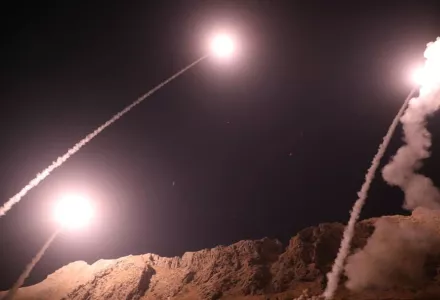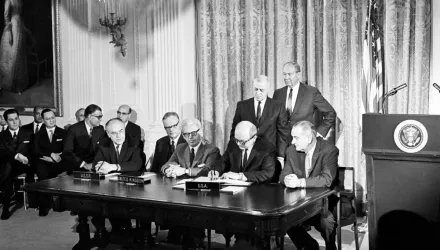
Syria today stands at the crossroads of regional and international geopolitical currents. The Arab uprisings of 2010–11 and the ensuing instability that shook the Syrian regime have created a strategic battleground for regional dominance and Great Power contestation.1 In the seventh year of the war, the conflict shows no sign of drawing to an end, but instead has entered a new stage. This phase is seeing a shift away from proxy war and an increasing risk of direct interstate clashes, with a real possibility of confrontations involving Israel, Iran, Turkey, Russia and the United States.
The partnership between Syria and Iran stretches back over four decades, and the bond between these two very different states raises an important research question for the field. What is propelling this enduring alliance in a region known for its dizzying array of constantly shifting partnerships? Many initially believed the alliance would be short-lived, tied as it had been to exigencies facing Iran and Syria during the Iran–Iraq War,2 or that it would not be strategically significant or durable owing to ‘underlying incompatibilities in their respective interests and aspirations and in the political ideologies underpinning the structure of their respective governments and societies’.3 These ideological differences—between Syria as a secular pan-Arabist state and Iran as a theocratic pan-Islamist power— were considered too fundamental to allow for any genuine long-term partnership even over shared geopolitical interests.
Nevertheless, in fact the partnership has not only endured but deepened over time. The reasons for this endurance lie largely in geopolitical factors and shared threat perceptions.4 Iran and Syria are drawn together by their opposition to the US-led regional security order, and this alliance reflects the desire of ‘middle powers’ to ‘defend their autonomy against intensive Western penetration of the Middle East’.5 These shared concerns explain how Syria and Iran were able to transcend their ideological differences to work towards shared visions of regional autonomy and reduced foreign penetration of the Middle East.
In recent years, especially since 2011, Iran has demonstrated its strong commitment to its ally and has been a major player in the Syrian conflict. Iran has consistently supported the Syrian government by sending military advisers to the country, establishing transnational militias there and providing political support in the international arena. Yet many mainstream analyses, which are largely divorced from theoretical frameworks, interpret Iran’s actions as expansionist,6 reflecting an attempt to recreate the Persian empire,7 by means including the creation of a land bridge from the Iranian plateau to the Mediterranean Sea.8 Others analyse Iranian behaviour through a sectarian lens, focusing on Iran as a predominant Shi’a power,9 or on Iranian anti-Israeli ideology.10
Many of these accounts, however, downplay or ignore Iranian security concerns and misread Iranian behaviour owing to an inadequate understanding of Iranian threat perceptions and strategic planning. There are exceptions. Some scholars have analysed Iranian strategy in the Syrian war through the prism of Tehran’s security concerns.11 Others have framed Syrian and Iranian foreign policies as a means of increasing regime resilience at home by using ‘foreign policy to acquire nationalist legitimacy from external threat’—an approach in which resistance to outside threats from actors such as the United States and Israel is used to legitimize centralization of power and popular mobilization for the regime at home.12 However, the limited periods covered by these works mean that they do not account for the full evolution of Iran’s strategy throughout the Syrian war.
To access the full article please see here.
--
* We would like to thank the three anonymous reviewers for their helpful feedback on an earlier draft of this article. We also thank Mohammad Sagha for his research assistance and critical engagement throughout the stages of this article as well as Sean Paul Ashley, Johannes Lang and Fridtjof Falk for their feedback and assistance, and seminar participants at Harvard University for their comments.
1 Leila Vignal, ‘The changing borders and borderlands of Syria in a time of conflict’, International Affairs 93: 4, July 2017, pp. 809–28.
2 Yair Hirschfeld, ‘The odd couple: Ba’athist Syria and Khomeini’s Iran’, in Moshe Ma’oz and Avner Yaniv, eds, Syria under Assad: domestic constraints and regional risks (Routledge: New York, 2014), pp. 105–24.
3 Shireen Hunter, ‘Iran and Syria: from hostility to limited alliance’, in Hooshang Amirahmadi and Nader Entessar, eds, Iran and the Arab world (London: Macmillan, 1993), pp. 198–216.
4 Jubin Goodarzi, Syria and Iran: diplomatic alliance and power politics in the Middle East (London: Tauris, 2006).
5 Anoushiravan Ehteshami and Raymond Hinnebusch, Syria and Iran: middle powers in a penetrated system (London: Routledge, 1997), pp. 88–91.
6 See e.g. Marc Champion, Jonathan Ferziger and David Wainer, ‘Israel, Saudis find common cause in warning of Iran expansionism’, Bloomberg.com, 18 Feb. 2018, https://www.bloomberg.com/news/articles/2018-02-18/ netanyahu-in-munich-speech-urges-west-not-to-appease-iran. (Unless otherwise noted at point of citation, all URLs cited in this article were accessible on 30 Nov. 2018.)
7 See e.g. James Stavridis, ‘What to do about an imperial Iran’, Foreign Policy, 30 June 2015, http://foreignpolicy. com/2015/06/30/what-to-do-about-an-imperial-iran-middle-east-persia-regional-dominance/.
8 See Ehud Yaari, ‘Iran’s ambitions in the Levant’, Foreign Affairs, 1 May 2017, https://www.foreignaffairs.com/ articles/iran/2017-05-01/irans-ambitions-levant; Dexter Filkins, ‘Iran extends its reach in Syria’, The New Yorker, 19 June 2017, https://www.newyorker.com/news/news-desk/iran-extends-its-reach-in-syria.
9 For one example, see Basheer Nafi, ‘Iran’s sectarian wars must be confronted, but not with more of the same’, Middle East Eye, 16 March 2017, http://www.middleeasteye.net/columns/irans-sectarian-wars-mustbe-confronted-not-more-same-452011045.
10 Karim Sadjadpour, ‘Iran’s real enemy in Syria’, The Atlantic, 16 April 2018, https://www.theatlantic.com/ international/archive/2018/04/iran-syria-israel/558080/.
11 Mohsen Milani, ‘Why Tehran won’t abandon Assad(ism)’, Washington Quarterly 36: 4, 2013, pp. 79–93; Nasser Hadian, Iran debates its regional role (Washington DC: Atlantic Council, Sept. 2015); Afshon Ostovar, ‘Iran, its clients, and the future of the Middle East: the limits of religion’, International Affairs 94: 6, Nov. 2018, pp. 1237–56.
Ahmadian, Hassan and Payam Mohseni. “Iran's Syria Strategy: The Evolution of Deterrence.” International Affairs, February 4, 2019
The full text of this publication is available via International Affairs.






